If they’re not already, Google Ads should 100% be part of your marketing strategy. They’re not just for big brand names. Small and medium-sized businesses can also make huge strides with this simple tool. In fact, the average ROI on Google Ads is about 250%!
Few marketing channels can compete. However, there’s a lot that goes into a stellar Google Ads campaign. Even aside from strategy, one of your first questions will probably be about Google Ads pricing. Anything that has that much potential must cost a lot, right?
Well, not necessarily. You’ll usually pay per click for a Google Ad, but the Cost Per Click (CPC) varies a lot.
Let’s explore all the factors that go into Google Ads pricing models so you can plan ahead and budget more effectively!
- How Much Do Google Ads Cost?
- Key Pricing Models in Google Ads
- Top Factors That Influence Google Ads Pricing
- Top Google Ads Bidding Models
- Budgeting in Google Ads
- Tips to Forecast Google Ads Costs
- Common Pricing Pitfalls and How to Avoid Them
- How to Reduce Google Ads Costs Without Losing Performance
- Campaign Type Pricing Breakdown
- Google Ads vs Other Platforms
- Tools for Managing Ad Spend
- Create Google Ads Campaigns That Convert
How Much Do Google Ads Cost?
Google Ads isn’t one-size-fits-all when it comes to pricing. Why? Well, because when you buy Google Ads, you’re essentially bidding against competitors in real time.
As it's a bidding model, Google Ads pricing models can vary widely depending on your:
- Industry
- Targeting
- Goals
However, we can offer a few averages that might help give you an idea how much you’ll pay:
An average new Google Ad campaign will cost around $20-$50 per day.
The Google Ads cost for most businesses is around $1,000-$10,000 per month.
Remember that Google Ads services pricing is highly variable. You could pay more, you could pay less. High-competition niches like legal or finance can see CPCs north of $50, while others like eCommerce or local services may stay closer to the lower end.
The good thing is you always control exactly how much you spend. So, in the end, it’s up to you!
Average CPC by Industry
Cost Per Click (CPC) is the standard Google Ads pricing model. And that CPC varies by industry. So, here’s a breakdown of current average CPC by industry:
- Legal Services = $6.75
- Consumer Services = $6.40
- Insurance = $3.44
- Auto = $2.46
- E-commerce = $1.16
- Real Estate = $2.37
- Medical = $2.62
- Technology = $3.80
- B2B = $3.33
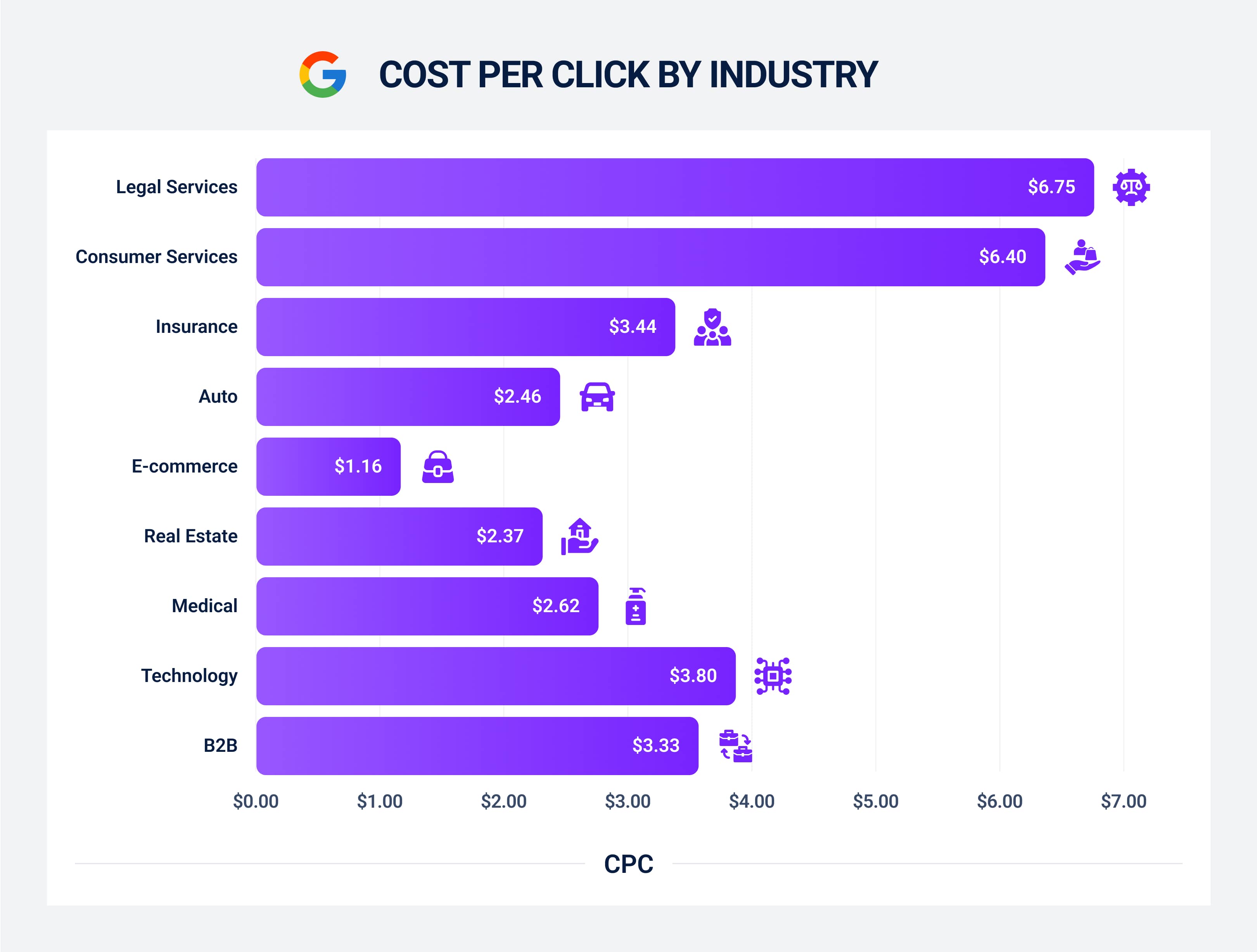
We got these statistics from WordStream, but there are other studies out there. It’s worth thoroughly researching your particular industry CPC average before you go ahead.
The key takeaway is that industries with high customer value like legal and consumer services will generally see a higher CPC.
Google Ads Pricing by Campaign Type
It’s important to realize that not all Google Ads campaigns are the same. Different campaign types actually come with different pricing dynamics.
Let’s take a look:
- Search campaigns - typically higher CPCs because they target users with immediate intent (people who are already searching for solutions so are more likely to buy).
- Display campaigns - generally cheaper but with lower conversion intent. Better for awareness.
- YouTube video campaigns - operate mostly on a cost-per-view (CPV) model, often under $0.10 per view.
- Performance Max and Shopping campaigns - rely on machine learning and can offer efficient CPCs if well-structured.
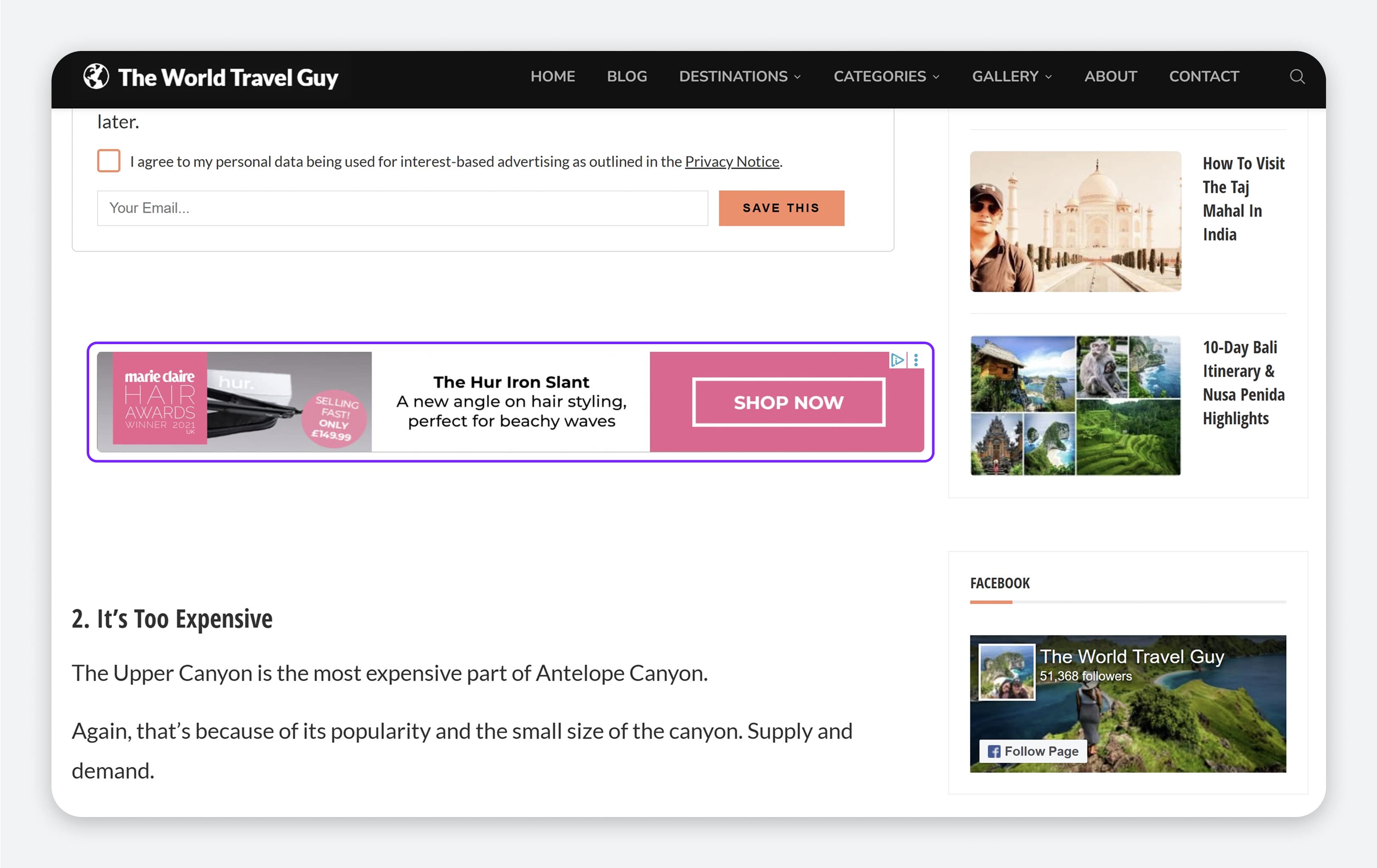
Try to look beyond price and figure out what you really want your ad campaign to achieve. Do you want to boost conversions? If so, search campaigns are probably best. If you simply want to get the word out and increase awareness, display campaigns might be more cost-effective. It’s all about your goals.
Cost Breakdown by Device, Location, and Time
There are other factors that affect Google Ads services pricing. Not all clicks are the same. Pricing reflects this. Costs can fluctuate quite dramatically based on when and where your ads appear, and how they’re interacted with.
Here’s what we mean:
- Mobile clicks - the average CPC on mobile clicks is slightly cheaper than desktop. But if your site isn’t mobile-optimized, conversions could get stuck.
- Desktop - pricier, but more effective for B2B and higher-ticket items.
- Location - advertising in urban areas or affluent zip codes, for instance, often comes with a higher CPC due to increased competition.
- Time - the time of day and day of week also play a role. Why? Well, if your audience converts better during business hours, bidding more during those windows makes sense. Helpful trick: you can use ad scheduling and device/location bid adjustments to stay efficient and maximize ROI.
Key Pricing Models in Google Ads
You might have noticed that CPC isn’t the only way to measure Google Ads costs. You’re going to need to become familiar with the different Google Ads pricing models in order to perfect your strategy.
Remember: each model has its strengths. But choosing the wrong one can drain your budget - fast.
Cost Per Click (CPC)
CPC is the most common model. Essentially, it means you’re charged when someone actually clicks on your ad.
However, you might already see a problem or two with this. What about bots, or accidental taps? What about all those “cheap clicks” that never convert? Won’t they just drain your budget?
Google does its best to precisely track clicks and filter out most invalid ones. Beyond that, it’s down to you.
CPC is ideal when you want to drive traffic to your site and can track what happens next, like purchases or sign-ups. You can increase the chance of those conversions by targeting strategically and optimizing your landing pages.
Cost Per Thousand Impressions (CPM)
You might also come across “CPM”. This is where you’re charged per 1,000 impressions regardless of clicks. Basically, Google counts an impression each time your ad appears (even if it’s not clicked).
This makes it great for:
- Reach - ideal for brand awareness campaigns where visibility is the main objective.
- Launching a new product - you want to get the word out as far and wide as possible but don’t necessarily need people to convert right now.
- Reintroducing your brand - CPM helps you stay top-of-mind.
The point here is not conversions (as with CPC). It’s awareness. That makes it more cost-effective for sheer visibility, but you’ll need to track upper-funnel metrics like view-through rates or brand lift to gauge success.
Cost Per View (CPV)
Here’s a pricing model that’s exclusive to video campaigns (mainly on YouTube): CPV.
Here, you pay when someone watches at least 30 seconds of your video (or the full thing, if it’s shorter) or interacts with it (like clicking a CTA or overlay).
It’s generally pretty affordable, too. The average CPV on a YouTube ad is just $0.026! That’s because success is harder; your targeting and video quality need to be top-tier to get results.
Again, you want people to convert, but CPV is generally best for:
- Storytelling
- Brand education
- Product demos
CPV really shines when you have a compelling message that’s hard to communicate in a static ad.
Cost Per Acquisition (CPA)
With CPA, you’re charged based on actual conversions (say, when a lead actually signs up or makes a purchase, not just clicks on your ad).
The tech behind this is super smart. Google uses historical data and Smart Bidding to optimize for users most likely to convert at your target CPA. It’s a powerful combo.
However, CPA models work best when you already have a solid conversion history in your account (usually 30-50+ conversions in 30 days). If your data is limited, the algorithm can struggle.
CPA is generally a favorite for lead gen and eCommerce brands that want predictable results and have piles of data to work with.
Target Return on Ad Spend (ROAS)
You might have noticed that a lot of Google Ads pricing models seem to focus on volume. That’s natural - the more clicks you get, the more you make.
However, Target ROAS shifts the focus from volume to value. Instead of optimizing for the most conversions, Google aims to bring you the highest return based on your revenue goals.
Let’s take an example:
You want $5 in sales for every $1 spent. Your target ROAS is 500%.
So ROAS is more focused on revenue than clicks. It’s great for eCommerce brands or anyone with clear revenue tracking in place.
The downside? It requires accurate conversion value tracking and enough data to feed Google’s algorithm. The better your data, the smarter the bids.
Top Factors That Influence Google Ads Pricing
There are a bunch of complex processes at work behind the scenes to determine the price you pay per ad. Your costs are ultimately shaped by how relevant your ad is and how your competitors behave. It’s crucial to understand these elements:
Quality Score and Ad Relevance
Google wants to reward advertisers who provide value to users. It reflects well on them when the ads they display give the user what they need, after all.
With this in mind, they assign a Quality Score (1–10) to each keyword based on:
- Expected CTR
- Ad relevance
- Landing page experience
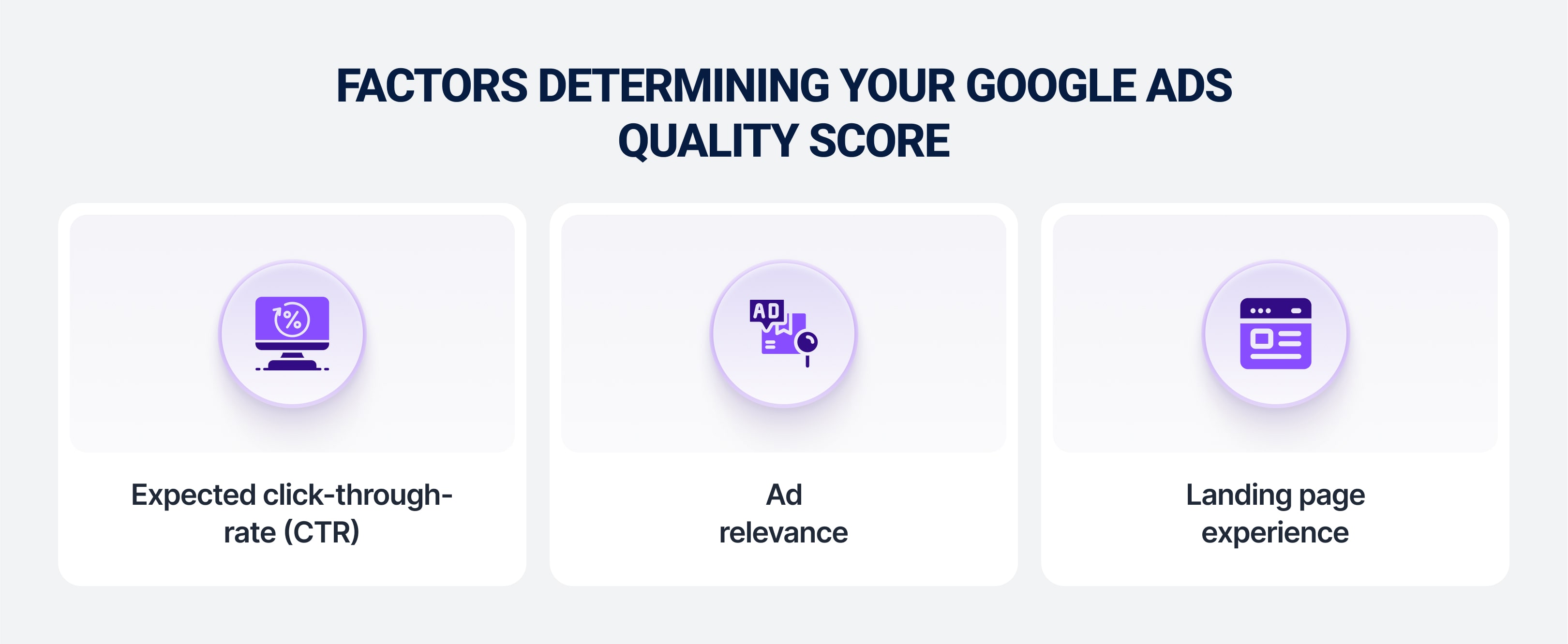
The good news is that a higher score actually lowers your CPC and boosts your ad rank even if you’re not the highest bidder! So, there’s a massive incentive to provide value.
If your ad tightly matches the searcher’s intent and leads to a useful, fast-loading page, you’ll pay less for better placement.
Match Types and Search Intent
Keywords aren’t all worth the same. We can think of them in three categories:
- Broad match - gives you the widest reach but can pull in low-intent traffic.
- Exact match - more targeted but limits volume.
- Phrase match - a balance between “broad” and “exact”
Here’s an example:
Targeting “buy Nike running shoes” will cost more but likely convert better than “running.”
The right keyword, then, is crucial. Smart advertisers align match types with intent:
- Broad for discovery
- Phrase for research
- Exact for high conversions
Competitor Bids and Auction Pressure
There’s a “live auction” element to Google Ads. What you pay is partly determined by what others are willing to pay for the same audience.
That means that if your competitors are going “all in” on the same keywords, prices will go up. Even more so during peak seasons or product launches.
This is where your Quality Score really makes a difference. You don’t just want to outbid your competitors - you can also outsmart them by providing a better experience. Win without overspending!
Bidding Strategy Selection
As always, strategy is everything. If you go into a live auction without any data at hand, you’ll either overpay or go home empty-handed.
Luckily, there are a few ways to go about this:
- Manual CPC - gives you full control but requires constant oversight.
- Automated strategies (Maximize Clicks, Target CPA, Target ROAS) - let Google adjust bids based on real-time signals.
Automated bidding can be a real game-changer. But you need to have enough conversion data and super-clear goals to make it work. Otherwise, you could end up draining your funds fast.
Audience Targeting and Signal Strength
Never underestimate the power of targeting. The perfect ad in front of the wrong eyes may as well be a blank page. The better you define your audience, the better your ads.
Google uses a mix of signals to determine who sees your ad. They include:
- Demographics
- Interests
- Browsing behavior
- Past site visits
So, it makes sense that strong first-party data (like customer lists) and refined in-market or affinity segments can improve both conversion rates and bid efficiency. Better targeting, better ROI. It’s that simple.
Account History and Conversion Data
Google actually goes out of its way to reward advertisers who provide a great user experience.
Let’s say you have a history of solid performance (strong CTRs, sparkling conversion rates, healthy budgets). The algorithm will give you better placement at a lower cost.
Don’t forget, strong data also means you can benefit more from those automated bidding systems!
The point is that you should think long-term and invest in clean, accurate tracking from day one.
Top Google Ads Bidding Models
Bidding is key to the whole Google Ads process. However, there are different bidding models to be aware of.
Each one is designed to align with different goals. Here’s a brief overview:
- Manual CPC - full control over individual bids.
- Enhanced CPC - half manual, half automated, with bids adjusting in real time based on likelihood to convert.
- Smart Bidding - Smart Bidding actually includes multiple strategies like Target CPA, Target ROAS, and Maximize Conversions. These are all fully automated and use machine learning to optimize performance.
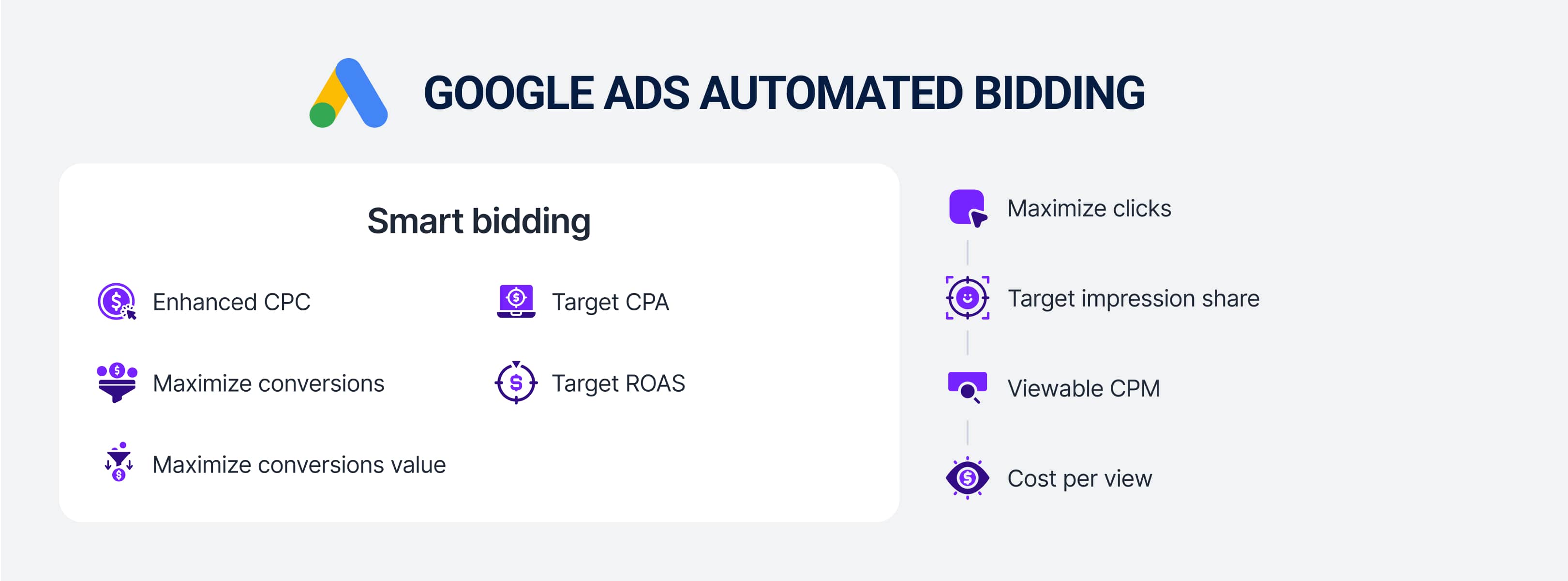
Let’s explore Smart Bidding in more detail:
How Smart Bidding Affects Ad Spend
You might be tempted by the idea of fully-automated bidding.
Smart Bidding is a powerful tool in the right circumstances. In fact, it usually outperforms manual bidding. However, it’s not exactly “plug-and-play”. It can definitely help you optimize for real business outcomes, but only if the system has the right signals and boundaries.
Here’s what we mean:
Smart Bidding Mechanics
Smart Bidding is all based around machine learning. The algorithm basically adjusts bids in real time. It does this by factoring in user signals like:
- Device
- Location
- Time of day
- Browser history
It adapts to each individual auction.
However, it’s not a 100% set-it-and-forget-it tool. You, the advertiser, still have a lot of control. For example, without your set goals (say, Target CPA or ROAS), the algorithm will have nothing to go on.
Plus, you’ll still need to constantly watch results. You’ll have to refine your audience signals and ensure clean tracking throughout.
Data Requirements for Stability
Data is at the heart of Smart Bidding. Without it, you may as well be throwing money down the drain.
In fact, data-poor Smart Bidding can lead to all kinds of costly errors as the algorithm might be tempted to chase conversions that may not be profitable. Or worse, tracking the wrong conversion actions can really lead down a rabbit hole.
Google generally recommends basing your Smart Bidding on:
- 30 conversions in 30 days for Target CPA
- 50+ conversions for Target ROAS
You should always be 100% clear what you want Google to optimize for - the algorithm can do the rest.
GROW YOUR INSTAGRAM FOLLOWING VIA OUR CELEBRITY CAMPAIGNS
Leverage the power of the worlds A-list celebrities to grow your Instagram every month
VIEW CAMPAIGNSLearning Phase and Adaptation
One thing first-timers often don’t realize is that Smart Bidding includes a 7 to 14-day learning phase for every new campaign. If you don’t realize this, it could be easy to panic.
That’s because during the learning phase, the algorithm tests different bidding behaviors, which can create an erratic performance.
Let’s be clear: you shouldn’t make changes! This will just reset the learning phase. Instead:
- Monitor performance closely
- Set a reasonable budget ceiling
- Allow the system to gather clean data
You should eventually see the performance stabilize!
Budget Controls and Risk Management
Smart Bidding can be a little scary, especially for those new to Google Ads, because it means giving up some control. What if you end up massively overspending?
The way to avoid this risk is to set up clear guardrails. For example, set:
- Bid limits or target ranges - prevent Google from swinging out of your financial comfort zone.
- Automated rules or Google Ads scripts - pause campaigns if spend spikes or CPA rise above your limits.
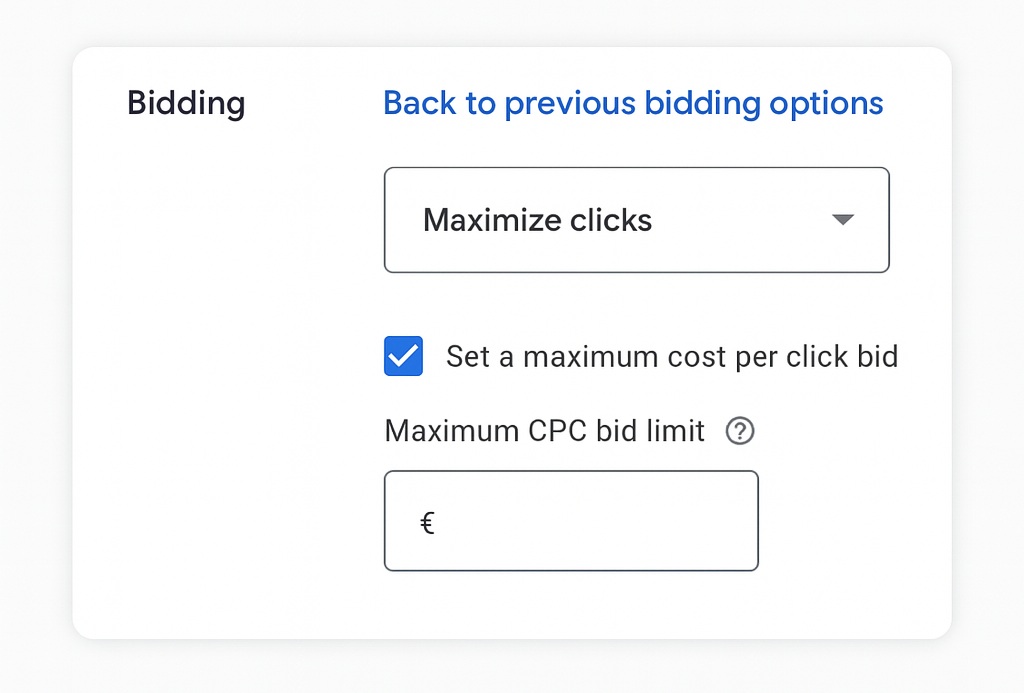
Remember, Smart Bidding is an efficient approach, but it’s not infallible. You’re going to have to hold its hand if you want to avoid ad spend inflation and get the best results!
Budgeting in Google Ads
Not every SME has thousands of dollars to spend on Google Ads. So it’s crucial not just to allocate money, but to allocate money wisely. You want to put your cash where it’ll get the best possible ROI.
Here’s how to do it properly:
Daily Budgets vs Monthly Spend
Many newcomers are confused by the fact Google Ads seemingly uses two budgets: daily and monthly. What Google actually does is use daily budgets to guide campaign spend and monthly limits to manage delivery.
Here’s what that actually means:
You’ll have a daily budget x 30.4 for a 30.4-day month. Google won’t go over this budget. However, your daily ad spend could actually fluctuate. If, for example, there’s a particularly high-performing day, Google will allocate more of your monthly budget to that day to capitalize on it (and spend less on lower-performing days).
Budget Pacing and Distribution
We often talk about “pacing” with regards to Google Ads spending. This is basically how Google spreads your budget throughout the day. You have two options:
- Standard delivery - spread your budget evenly throughout the day. Most advertisers prefer this. It prevents early burnout and ensures consistent visibility without draining your budget before noon.
- Accelerated delivery - spend as fast as possible (only available on some campaigns). Some advertisers want to boost visibility as fast as possible, which makes accelerated a good option.
Shared Budgets Across Campaigns
Budgeting could fast become complicated if you’re running multiple campaigns at once. Luckily, there’s a feature to solve this, too.
Google allows “shared budgets”. This is where multiple campaigns draw from the same budget pool. There are a few reasons shared budgets are so handy:
- Campaigns have the same goal - say every campaign is there to build brand awareness across several networks or product categories.
- Simplified budget management - one budget, multiple campaigns.
- Fund what works - Google auto-allocates ad spend to the best-performing campaigns without any manual input whatsoever!
Over delivery Explained
You may be watching your Google Ads metrics and notice an alarming budget spike on one particular day. You might think it’s some kind of bug.
It isn’t. This is by design. It’s what we call “over delivery”.
Essentially, Google may spend up to 2x your daily budget on high-traffic days. The algorithm wants to maximize your results without exceeding your monthly cap - but not exceeding your monthly cap means it can still technically exceed your daily budget.
This is helpful. However, when it comes to cash flow, sudden spikes can be annoying. It’s still best to monitor your spend at least weekly.
Budget Recommendations by Campaign Type
So, what should an SME really be setting aside for each Google Ads campaign type? What are the “rule-of-thumb” figures?
It’s tough to say precisely as there’s a huge number of variables at play. Generally, though, these figures should be about right:
- Search campaigns - $20–$50/day if using CPC or CPA bidding is a good target.
- Display or Discovery - lower budgets of $10–$30/day are usually enough (because CPCs are cheaper).
- Video campaigns - even less, $5–$15/day should do.
- Smart Bidding - you should approach Smart Bidding from the other direction. For example, plan for at least 30–50 conversions/month, and back into your budget from there.
Tips to Forecast Google Ads Costs
You may be starting a new ad campaign or even scaling an existing one. Either way, forecasting is essential. You need a reliable cost estimate in order to:
- Set realistic goals
- Control risk
- Align ad spend with business outcomes
Here’s how to do it:
Using Keyword Planner for Cost Estimates
Your first stop should definitely be Google’s Keyword Planner. This handy tool tells you everything you need to know about your keywords, including CPC ranges and search volumes. What’s more, you can even tailor your projections by filtering based on:
- Location
- Language
- Device
Okay, it’s not perfect. But it does give you a reliable ballpark CPC and potential daily spend based on your budget and bid strategy.
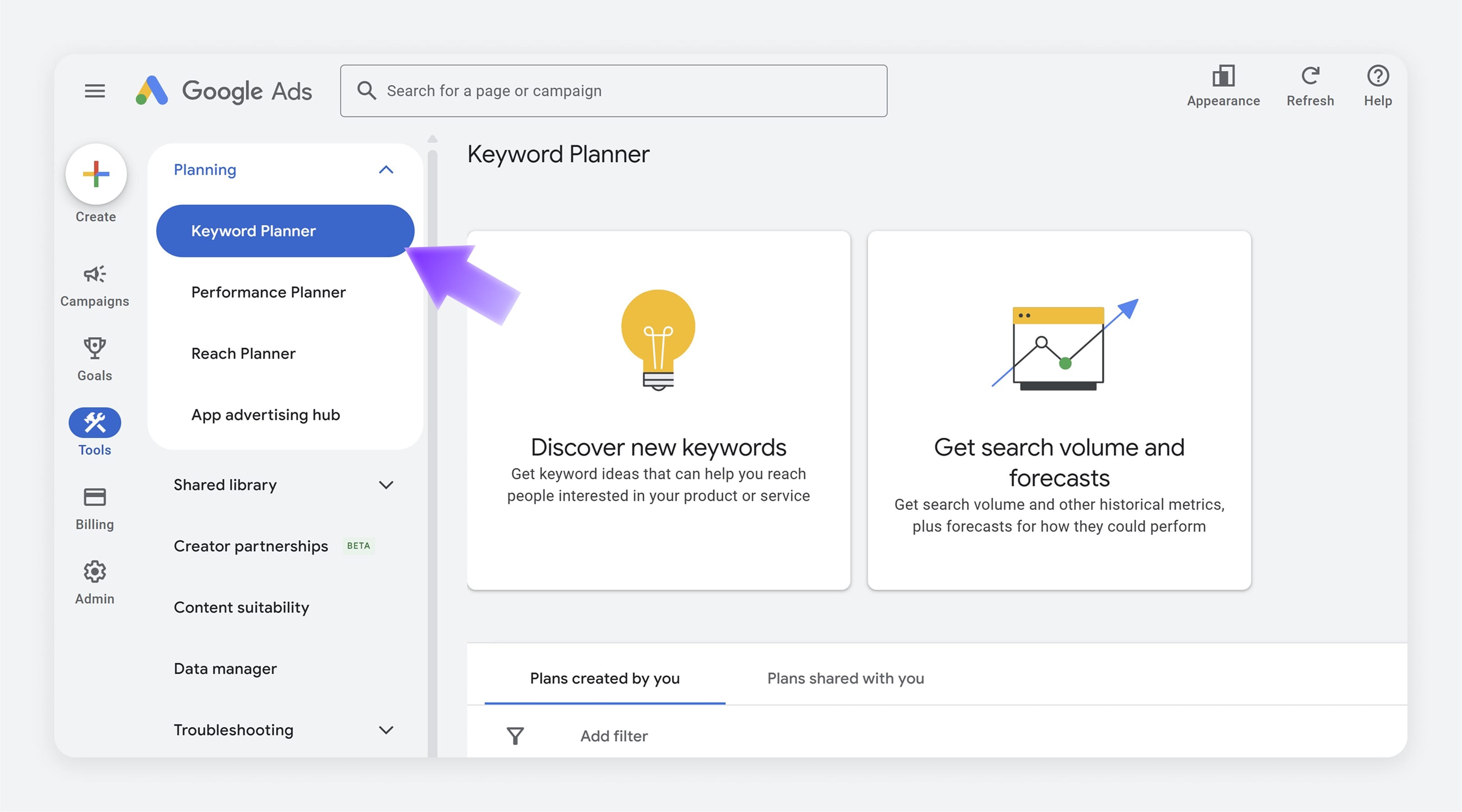
Planning Budget Around CPA or ROAS
Many SMEs make the mistake of simply guessing ad spend arbitrarily. We don’t recommend that approach.
Instead, try this: reverse-engineering your budget based on your performance targets.
This is actually a very simple process. Choose your target CPA to start with. Let’s say that’s $50. You know you want to gain 100 leads. You can now allocate $5,000 for ad spend.
It’s a little different for ROAS. Here, you should start with your revenue goal (let’s say $10,000) and divide by your target return (400%). This will tell you your budget ($2,500 in this case).
Estimating Spend for New Campaigns
Basing your budget on CPA or ROAS is great if you have plenty of historical data to work with. If you don’t - let’s say you’re a startup launching a new campaign - things are different.
In this case, you should start with small, controlled budgets. The best thing to start with is a benchmark from your industry and model expected outcomes from there.
Example:
- Average CPC in your industry is $2 and average conversion rate is 5%.
- You’ll need 20 clicks for one conversion. That’s $40.
- Let’s say you want 30 conversions. That would be roughly $1,200.
Don’t forget to factor in testing costs, too, as these can add to your expenses.
Forecasting Tools and Techniques
Keyword Planner is a good start, but it won’t take you all the way. You’ll probably want to integrate some more tools, too.
We recommend:
- Google Ads Performance Planner
- SEMrush
- Ahrefs
These are proven tools that SMEs like yours use every day to perfect their Google Ads strategies.
Here are a few techniques to forecast more effectively:
- Build a simple forecast using estimated CPC, CTR, and conversion rate to simulate different scenarios.
- Add in seasonal trends or competitor behavior.
- Run pilot campaigns to gather real-world data if you can afford it.
Common Pricing Pitfalls and How to Avoid Them
Like the sound of a 6% conversion rate? Those kinds of figures are certainly possible with Google Ads. But only if you get your strategy right.
Too many SMEs fall into traps that quietly drain budgets - even when their ads aren’t necessarily bad.
Let’s explore some of those traps:
High Spend and Low Results
Most businesses spend around 10% of their budget on ad spend. That’s a lot of money. However, many of those end up with weak returns (which may even lead them to spend more in the hopes of increasing ROI).
But the truth is, ad spend isn’t the problem. It’s usually down to:
- Misaligned targeting
- Poor tracking
- Irrelevant keywords
In other words, it’s the strategy that’s falling flat.
That’s why research is so important. You have to get the ball rolling with campaign goals and keyword quality checks. Plus, make sure you use Google Ads’ built-in diagnostics and segment reports to isolate weak areas.
Broad Match Without Audience Controls
Broad match can bring in a lot of traffic, which can appear promising to the untrained eye. However, many businesses soon realize the hard way that it’s the wrong traffic. No one is converting.
The trick is to always combine broad match with audience targeting, such as in-market segments or custom intent lists, to guide who sees your ads. We also recommend using negative keywords aggressively to prevent waste!
Bad Landing Page Experience
Got the perfect ad and the perfect bid? Well, that’s only half the battle. Getting users to click on your ad is one thing, but presenting them a stellar landing page that leaves them no choice but to convert is another.
Too many landing pages are slow, confusing, unappealing, and misaligned with the ad itself. That’s bad for your Quality Score as well as your conversion metric.
Here’s a bad landing page:
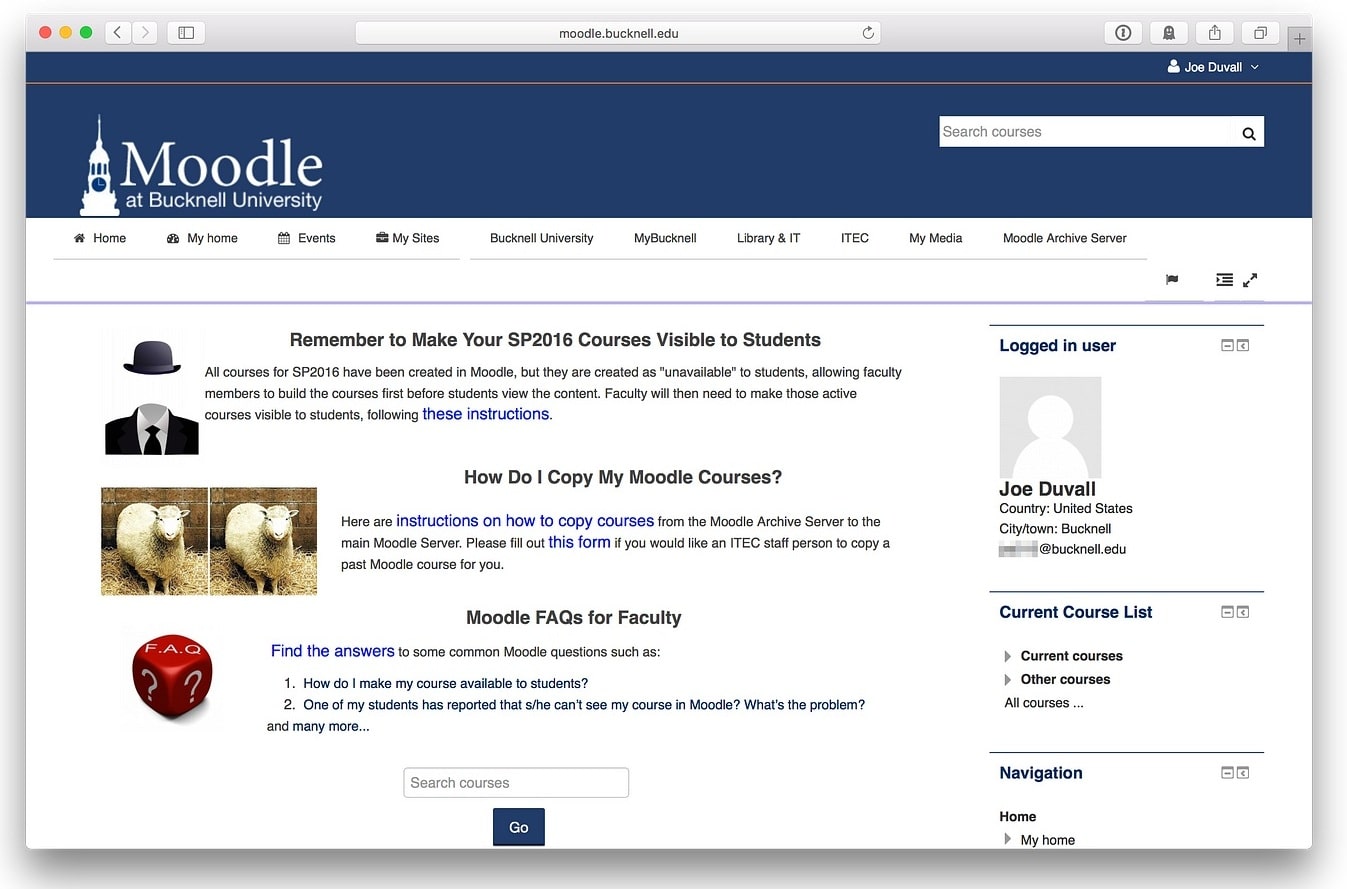
And here’s a good one:
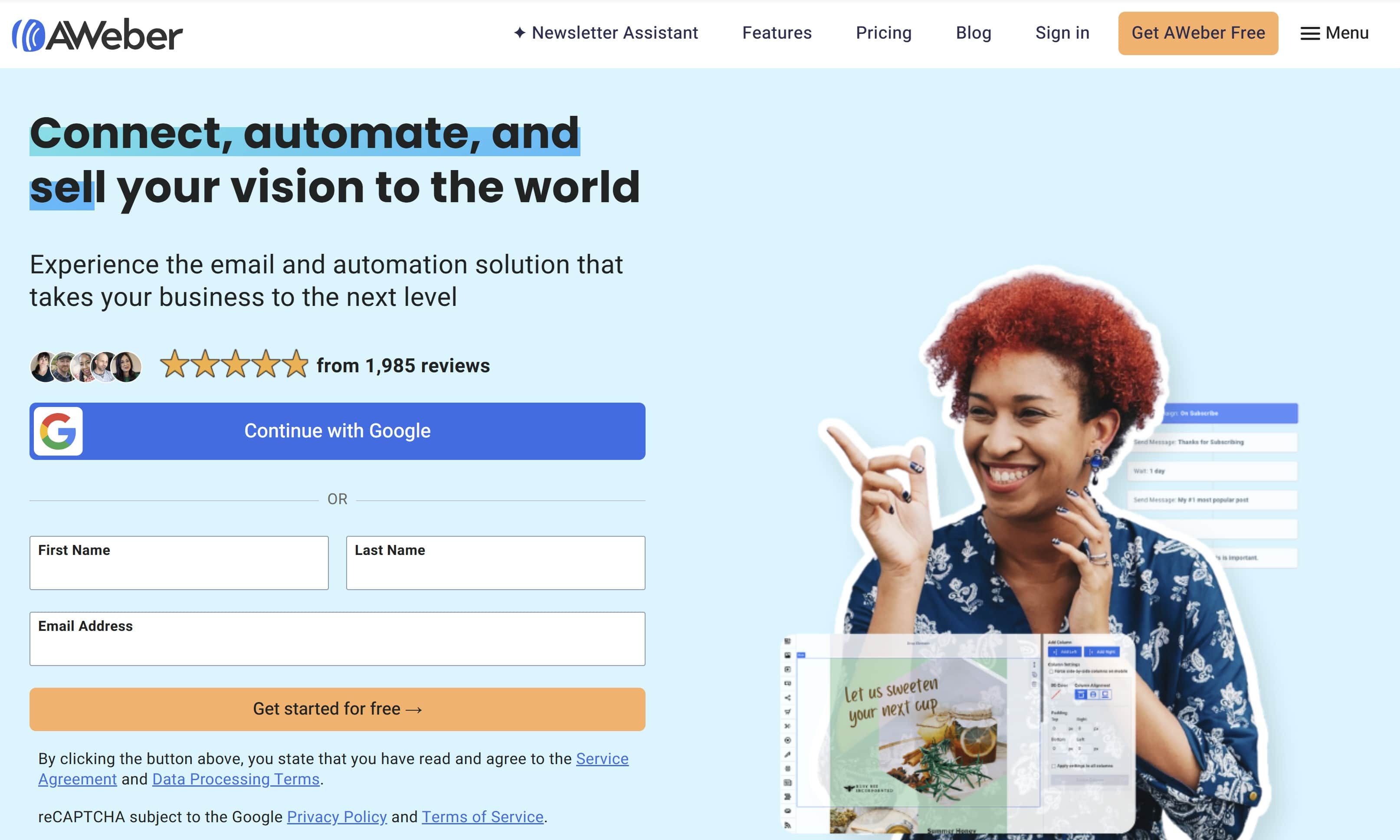
The best solution is to make sure your landing pages are 100% optimized from the outset. Test them and test them again. Ensure they load fast and guide users clearly to your goal!
Wrong Bidding Strategy for Funnel Stage
It’s easy to mismatch funnel stages with bidding strategies. For instance, using Target ROAS at the top of the funnel or Maximize Clicks at the bottom can cause serious inefficiencies.
Here’s a quick breakdown of what you should be doing:
- Awareness campaigns - stick to CPM or CPV.
- Mid-funnel - use CPC or Maximize Conversions to drive engagement.
- Bottom-funnel - focus on CPA or ROAS with conversion tracking.
Don’t just think about what you want to happen. Also consider the user’s readiness to act.
Overreliance on Automation
Many businesses see Smart Bidding as a shortcut, an entirely hands-off approach. But that can lead to serious overspending while your back is turned.
Smart Bidding still relies on:
- Strong data
- Clear goals
- Regular oversight
All of that requires serious participation from the business owners/managers. Think of automation as a co-pilot: it can cruise, but it shouldn’t be left in charge of take-off and landing.
How to Reduce Google Ads Costs Without Losing Performance
Let’s now think about how businesses can actually save money on ad spend while improving ROI. Let’s make Google Ads pricing work for you:
Use Negative Keywords
It’s all about percentages. One of the best ways to increase, say, your conversion rate, is to actively block irrelevant traffic.
That’s actually much easier than you might imagine. To do this, we use “negative keywords”.
These are specific keywords that prevent your ads from showing up for searches that don’t match your offer. For example, if you sell premium software, you might want to block keywords like “free” or “open source”.
The idea is to keep your budget focused on high-intent clicks that are more likely to convert.
Bid Adjustments by Segment
Within Google Ads pricing packages, you can usually adjust bids by device, location, time of day, and even audience segments.
This helps allocate your resources where they have the highest impact and hold back where they lag behind. Let’s say, for instance, your mobile traffic converts better. It makes sense to increase your mobile bid, right?
These adjustments can seriously improve efficiency over time without ever cutting reach.
Split Testing and Optimization
Testing beats guessing every time. A/B testing specifically. It’s a great idea to A/B test everything from ad copy to CTAs to see what resonates more strongly. These things can make a real difference to your bottom line.
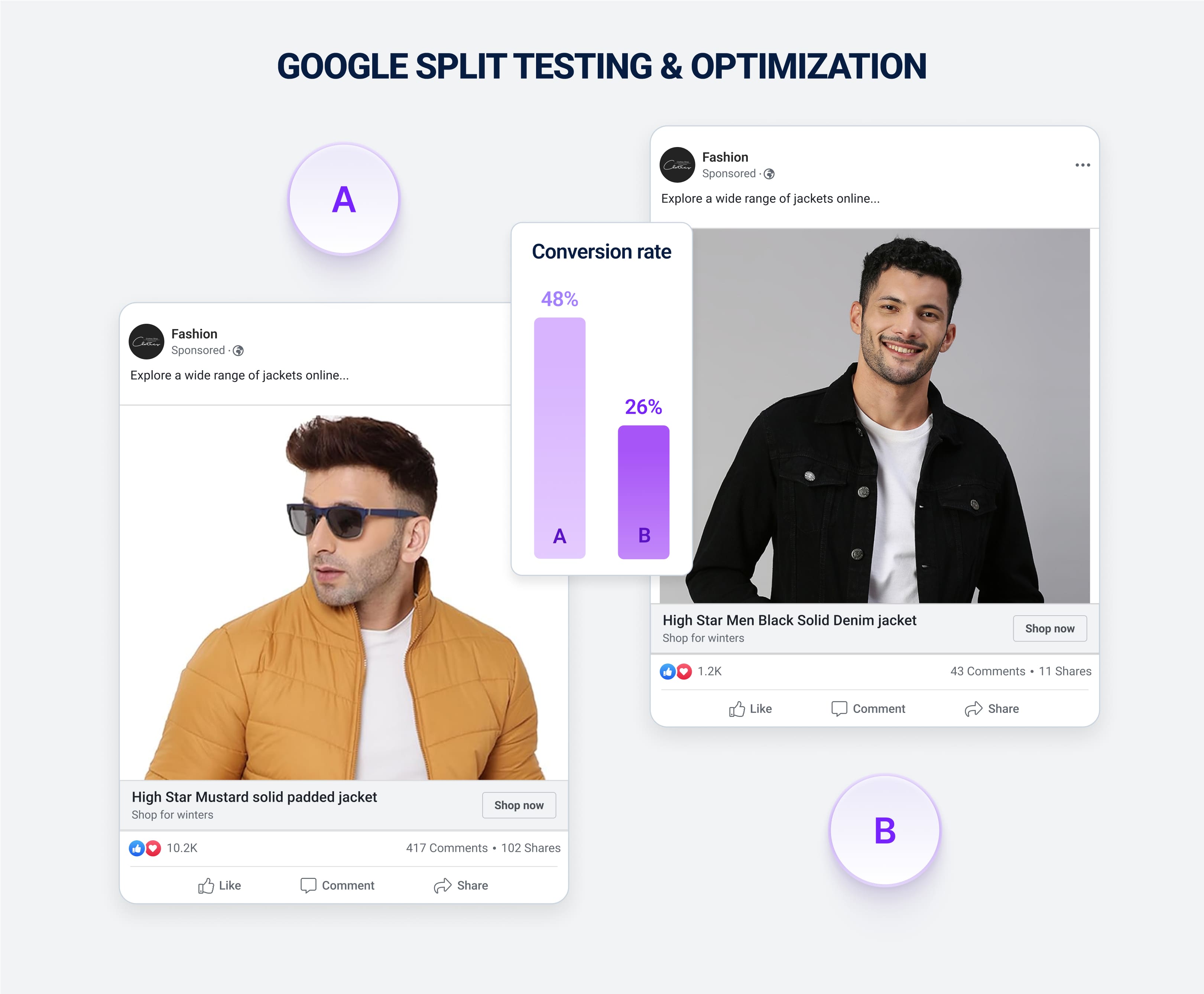
Use Responsive Search Ads to test multiple variations automatically, or run manual experiments for more controlled insights. Even tiny changes can yield amazing results and even increase your Quality Score! Google ads pricing for Responsive Search Ads works similarly to standard ads via a bidding model.
Conversion Tracking Accuracy
Tracking the wrong things equals wasted money. That’s because when you track conversions inaccurately or incompletely, Google will end up optimizing the wrong actions (say, page views instead of conversions).
Make sure your:
- Tracking is clean
- Includes primary business goals
- Covers every step of the funnel
When conversions are accurately tracked, bidding strategies get smarter. That means less ad spend waste all round.
Campaign Type Pricing Breakdown
Google Ads pricing doesn’t just depend on the pricing model, but also on the type of campaign you’re running. This is essentially another way to formulate your Google Ads strategy - looking at it from the angle of what type of ad campaign you need.
Here’s a detailed breakdown:
Search Campaigns
These are campaigns wherein you try to target users who are searching for relevant keywords. Say a user types in “cooking supplies near me” - you want your store to show up first.
These types of searches are called “high intent”. In other words, the user is already intending to buy something and is searching for the best offer. Because of that, CPC is usually higher. Costs can range from $1 to $15+ per click, depending on the industry and competition.
These campaigns work best when you have:
- Well-defined keywords
- Strong conversion tracking
- A clear funnel strategy
Display Campaigns
Display campaigns aren’t as targeted as search campaigns. You’re displaying ads to as wide an audience as possible (the Google Display Network reaches over 90% of users) in an effort to increase awareness, but you’re not targeting “high intent” traffic.
That means lower CPCs - often $0.20 to $1.00. However, it can also mean wasting your budget on uninterested audiences if not done right.
Shopping Campaigns
Shopping campaigns are driven by product-level ads and tend to operate on a CPC model similar to Search, though generally a bit cheaper ($0.50 to $2.00 CPC range is typical).
These ads pull from your product feed and show images, prices, and titles directly in search results. Google product listing ads pricing is pretty low and works especially well for eCommerce brands. All you need is a clean, optimized product feed!
YouTube Campaigns
Video campaigns on YouTube are actually one of the cheapest ways to advertise. CPV usually only costs around $0.01 to $0.10. Plus, it’s a great way to showcase your brand in a more in-depth ad.
However, you’ll also have to spend more actually making the ad, and only the very best convert in big numbers.
Performance Max Campaigns
Performance Max is a real gem for advertisers. These campaigns are fully automated, running across all Google channels—Search, Display, YouTube, Gmail, and Discover. However, you don’t control CPCs directly.
Instead, Performance Max pricing is dynamic. You set a goal (say $40 CPA or 400% ROAS) and let Smart Bidding do the rest. Google allocates spend across assets and placements accordingly.
Google Ads vs Other Platforms
Google Ads isn’t the only advertising option. In fact, other platforms might deliver better ROI (depending on your goals).
Here are Google Ads’ main competitors and how they stack up:
Facebook and Instagram
Meta is undoubtedly an attractive option for advertisers. It has lower CPCs for starters, at just $0.70 on average. Plus, both Facebook and Instagram ads excel at:
- Visual storytelling
- Behavioral targeting
- Top-of-funnel reach
Users tend to like that it’s more of an interruption than responding to a search, so creatives and audience segmentation carry more weight. It’s also a powerful complement to Google for e-commerce brands.
However, the traffic is less intent-driven, so conversion rates could be lower.
Microsoft Ads
Microsoft Ads is very similar to Google Ads in terms of structure. However, it has a much smaller user base. That means less potential reach (average CTR on Microsoft Ads is 34% lower than with Google Ads).
That said, less competition can be a good thing. Microsoft Ads tends to be cheaper with an average CPC of around $1.54. Plus, the audience skews older and more affluent, which can be handy if you’re targeting a, say, a B2B or financial niche.
LinkedIn, TikTok, and Other Alternatives
All alternatives have their unique strengths. Let’s take a look:
- LinkedIn Ads - fantastic for B2B advertising, but come at a premium. The average CPC for LinkedIn Ads is $3.94 - but that can go up as high as $10.00. But conversions are high. If you’re targeting by job title, company size, or industry, it’s unmatched.
- TikTok Ads - growing rapidly with a low CPV and strong organic-style reach for Gen Z and Millennial audiences.
- Pinterest, Reddit, X - other native advertising channels can definitely work, but may need channel-specific creatives and tight targeting to justify spend.
Tools for Managing Ad Spend
Some companies have whole departments managing their ads. That should hint that there’s a lot more to it than simply setting daily budget limits. Tracking and optimizing are both serious components of a killer ad strategy.
These tools should smooth things over:
Google Ads Budget Reports
You’ll find Budget Reports inside the Google Ads interface. It essentially gives you a daily and monthly breakdown of how your campaigns are pacing.
You can:
- View projections based on past performance
- Analyze historical spend trends
- Spot unexpected spikes
It’s a great way to compare your actual ad spend to your targets and make mid-month adjustments before things go off track.
Google Analytics 4
Let’s take things beyond ad budgets. After all, you want to know how clicks actually turn into conversions, right?
GA4 gives you a deeper look at post-click behavior and helps connect ad spend to true business outcomes. That means you can build custom reports and even use prebuilt attribution models to get more insight.
Just make sure to link your accounts properly and configure events to match your conversion goals!
Looker Studio Dashboards
Dashboards are indispensable when we’re managing Google Ads. They put everything in one place and give you a digital HQ from which to oversee the whole campaign. For our money, Looker Studio is the best at this.
It lets you turn raw ad data into visual dashboards that pull in real-time data from Google Ads, GA4, and other sources to track spend, CPA, ROAS, and more.
If you want to ditch the spreadsheets and “clean up” your process, it’s a must.
Third-Party Tools
You might not be at the stage of needing more advanced control just yet. But when you are, come back and check out tools like:
- Supermetrics
- Optmyzr
- Revealbot
- Adalysis
Tools like these can do everything from automating budget monitoring to detecting anomalies on a tiny scale. Some even offer AI-driven alerts or predictive pacing to help you avoid over/underspending.
Create Google Ads Campaigns That Convert
There’s a lot that goes into the perfect Google Ads campaign. To get it right without costly trial and error, partner with a paid search marketing team that has the skills and experience you need to land your message and covert.
Frequently Asked Questions
Why does my Cost-Per-Click vary so much?
CPC is in constant fluctuation. It varies based on competition, Quality Score, keyword intent, time of day, and even device type. And, as Google Ads functions like an auction, costs can rise as more advertisers go for the same keywords.
What affects my quality score and how does it impact pricing?
Google wants to be useful. So, it bases your quality score on expected CTR, ad relevance, and landing page experience.
A high quality score gives you a lower CPC. A low score can increase your CPC even if your bids are high. So improving your ads is a real must.
Are branded keywords cheaper than non-branded ones?
Generally, yes. Why? Branded keywords tend to have two things: high quality scores and low competition. They’re also more likely to convert since users are actively looking for your brand.
Is manual bidding still worth it?
Manual bidding is definitely less efficient than Smart Bidding, no doubt about it. However, manual bidding isn’t without its pros: it offers much more control and might work well for tightly targeted campaigns or niche B2B funnels.
What pricing model is best for lead generation?
Lead gen pros tend to favor Cost-Per-Acquisition (CPA) or Maximize Conversions. These models focus on driving real results rather than just traffic.

